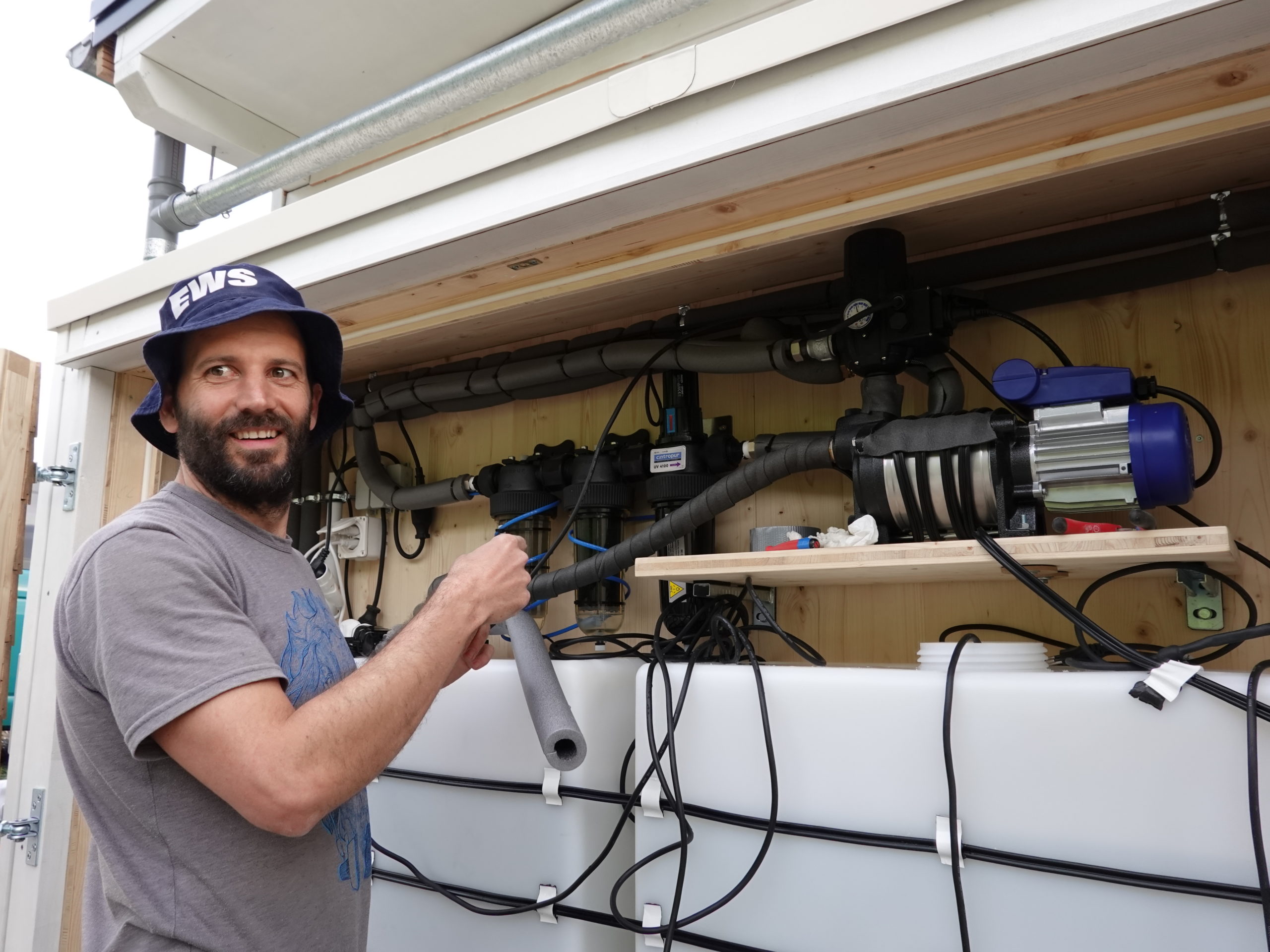Discover Members & Projects
Our members

URIMAT Schweiz AG
Topics: Housing & Living
We are a leading manufacturer of waterless urinals and environmentally friendly products in public and semi-public sanitary facilities.
InformationsURIMAT Schweiz AG
Topics: Housing & Living
We are a leading manufacturer of waterless urinals and environmentally friendly products in public and semi-public sanitary facilities.
Waterless urinals from the Swiss manufacturer URIMAT have become widely accepted and ensure good hygiene and environmental protection in thousands of men’s toilets around the world. Thanks to the innovative technology and high value retention of our products, new customers are turning to our solution every day and actively helping to save millions of litres of clean drinking water.
URIMAT is committed to environmental sustainability. Our products are produced in accordance with environmentally friendly practices and materials. In choosing our partners, we look at carbon-neutral production and ethical principles.
We are supporting circular economy systems especially peecycling technologies worldwide.

Alan Gerster
Topics:
My goal is to learn as much as I can about resource-oriented sanitation in urban areas and technologies for recycling nutrients from wastewater streams. So here I am, trying to participate in the activities and workshops offered by the VaLoo association!
InformationsAlan Gerster
Topics:
My goal is to learn as much as I can about resource-oriented sanitation in urban areas and technologies for recycling nutrients from wastewater streams. So here I am, trying to participate in the activities and workshops offered by the VaLoo association!
I am working part-time on my master’s thesis on circularity indicators for assessing the circularity of nutrients (N, P, K) in the study case of the zirkulierBAR-project in Brandenburg (DE) and part-time in the cantonal administration as an intern at the Department of Domestic Water Supply and Waste Disposal in the canton of Bern (CH)
Alan Gerster
alan.gerster21@gmail.com
Andri Heidler
Topics: Housing & Living, Collection & Treatment, Reuse & Production
My work focuses on advancing the enabling environment for ressource oriented sanitation in Switzerland, with a particular focus on the legal and political framework.
InformationsAndri Heidler
Topics: Housing & Living, Collection & Treatment, Reuse & Production
My work focuses on advancing the enabling environment for ressource oriented sanitation in Switzerland, with a particular focus on the legal and political framework.
For VaLoo, I am responsible for coordinating the Advocacy Working Group. If you want to know more about VaLoo’s advocacy work reach out to me, become a member, and join the Advocacy Working Group!
Implementations by our members
PhD on Vermifiltration
Topics:
- Collection & Treatment
I am currently doing a PhD which aims to answer the following questions:
- How does a full-scale vermifilter perform? (Case study: Soubeyran)
- How does the effluent of full-scale vermifiltration installations compare to irrigation and fertigation standards?
- What is the removal of pathogens, heavy metals, and common house-hold micropollutants?
- What are the mechanisms for nitrogen treatment and how do operational parameters affect these mechanisms (lab-scale)
- How do full-scale vermifilters compare to lab-scale vermifilters?
- in terms of treatment efficiencies, greenhouse gas emissions, nitrogen cycle
- Based on the collected knowledge, how can vermifiltration be optimized?
University of Geneva
University of Geneva, Geneva, Switzerland
kayla.coppens@unige.chhttps://ch.linkedin.com/in/kayla-coppens-921b0710a
The Ressourcer V1-2024 by EAR
Topics:
- Collection & Treatment
- Reuse & Production
The Resourcer V1 is designed to combine several circular processes:
- a grow house for seedlings and plants powered by passive and active solar power.
- Electric power will supply controlled LED, humidity and temperature adjustments to enhance and prolong the natural season in the mountain area (Emmental 700 m ü.M).
- a dry toilet, separating the (re-)source material into liquids and solids.
- a feces fermentation and/or worm compost installation with drawers or a box system.
- fermented urine with evaporation installation and treated fertilizer as outcome.
- streetnoise absorption for a better garden sound.
- rainwater collector to repurpose.
- 30cm lower planting bed to use earth’s warmth into the machinery.
- tree-grow-facility as in winter protection.
- material to construct the Resourcer V1 is re-used from another construction site
- prototype and study facility like using the irradiation of the battery to enhance the composting.
- Researching on psychology of water-flush sounds.
- Collecting data on the experience of the usage of such a system from the makers and the audience of EAR.
Purpose and goal:
The Resourcer V1 project aims to grow organic material such as seedlings, bacteria, biological material, and plants using the techniques of the Resourcer V1 system. This project presents a perfect challenge for a dedicated team and aligns with the core vision of EAR.
The Resourcer V1 is an off-grid system that consists of a greenhouse with four compartments. The first compartment contains a dry-toilet and urinoir, the second compartment controls the compost climate of feces and greens, the third compartment facilitates urine-to-fertilizer evaporation, and the fourth compartment is used for growing seedlings, plants, and conducting other experiments.
The surrounding EAR garden of approximately 100m2 can nurture the seedlings that grow into food. The kitchen and community will process these plants, keep the seeds separated for the next season, and mix coffee waste and tea leaves into the circular processes. Additionally, these processes can be used to grow mushrooms and produce vegan leather. The (wurm-)compost produced by the Resourcer can be mixed into the normal compost.
The construction will also improve the soundscape in the garden, since it is built with a sound-absorption that lowers the traffic-noise.
In summary, the Resourcer V1 project is an off-grid system that aims to grow organic material using a combination of greenhouse and circular processes, aligning with the core vision of EAR. The surrounding garden, kitchen, and community play an important role in nurturing the seedlings, processing the plants, and contributing to the circular processes that keep changing and hopefully expanding.
Dimensions
The dimensions of the project are (lxbxh) 6mx 1,5 (2m roof) x 1.9-2.2m and the construction takes place in 2024. It will replace the existing shed that needs complete renovation.
Realization / timeframe
EAR will invite volunteers who have great expertise on different aspects of the project. Together we want to make a journey into combining several processes in 1 dedicated machinery that intrinsically motivates to mix in the different circularities.
Ending up with a real yield with home-made fertilizer, understanding of great compost, a knowledge on different fermenting systems, clever evaporation, controlling low-energy computers for climate-regulation and many more interactions will be found in the realization of this project.
Pls reach out to Philipp Markus for more details on the timeframe etc…
EAR Environmental Artistic Research
Philipp Markus (Sanitation Consultant), Kaspar König (Founder EAR)
Trubschachen, Schweiz
philipp.markus@bluewin.chhttps://ear.education/
Stammhäuser
Topics:
- Collection & Treatment
- Housing & Living
- Reuse & Production
Unsere Welt ist bereits erbaut, doch wie können moderne, ökologische Themen in dieses bestehende Gefüge integriert werden? Die Stammhäuser der Wohnbaugenossenschaft Hofgarten sind herausragende Beispiele dafür..
Die geplante Instandsetzung dieser Gebäude legte besonderes Augenmerk auf die Minimierung des Ressourcenverbrauchs und die Anpassung an den Klimawandel. Durch eine sanfte Sanierung konnten bestehende Elemente erhalten und wiederverwendet werden, wie beispielsweise die Küchen. Andere Elemente wie Duschen wurden komplett neu gestaltet, jedoch auch im Kreislaufkonzept durchdacht. Die Bewohner tragen aktiv zum Klimaschutz bei, indem sie einen Teil der Wärme aus dem Abwasser während des Duschens einfangen und ins System zurückführen. Diese innovative Wärmerückgewinnung findet direkt in der Duschrinne statt und wurde in Zusammenarbeit mit unserem Industriepartner Joulia umgesetzt, die verschiedene Bauformen der WRG-Rinnen anbieten. Ziel war es, die grösstmögliche Effizienz zu erreichen, was uns gelungen ist. Die Herausforderung bestand darin, den nötigen Platzbedarf für den Wärmetauscher zu finden. Da sich dieser direkt in der Duschrinne befindet, musste die Holzbalkendecke mit Schlackefüllung als Raum herhalten. Gleichzeitig wollten wir keine Kompromisse in Bezug auf Dichtigkeit, Schallschutz und Brandschutz machen. Das Fazit lautet: Es geht, und zwar mit Erfolg.
Neben diesem aktiven Beitrag zum Klimaschutz wurde auch an die Klimaanpassung gedacht. Das Gebäude profitiert von einem begrünten Freiraum abseits der Strassen, der speziell für die Hitzeminderung optimiert wurde. Ab dem Frühling 2024 tragen offene Mulden zur Hitzeminderung bei, indem sie das Dachwasser verdunsten und versickern lassen. Vor den Mulden sind einzelne Regentonnen platziert, die eine einfache Nutzung des Regenwassers ermöglichen.
Solche Projekte erfordern eine offene Bauherrschaft und grosses Vertrauen in das Projektteam. Die Wohnbaugenossenschaft Hofgarten hat uns beides grosszügig geschenkt.
Moser's Büro GmbH
Kristijan Moser
Siewerdtstrasse 95, Zürich, Schweiz
0434562333kmo@xn--mob-joa.chhttp://www.mobue.ch
Horizontal flow constructed wetland (HFCW) greywater treatment system
Horizontal flow constructed wetland (HFCW) greywater treatment system
Topics:
- Collection & Treatment
- Housing & Living
A Horizontal flow constructed wetland (HFCW) greywater recycling system is designed and installed by alchemia-nova GmbH at the apartment complex FELZ ZWEI, which was realized by VBAU Architecture in Zürich, Switzerland in 2021. ZHAW was evaluating the cleansing capacity and water quality; the potential water, energy and financial savings; as well as the user acceptability of reusing treated greywater for toilet flushing and garden irrigation.
VBAU, Alchemia Nova, ZHAW
Maximilian Grau
Girhaldenstrasse 20, 8048 Zürich, Switzerland
grux@zhaw.ch
KREIS-Haus
InformationsKREIS-Haus
Topics:
- Collection & Treatment
- Housing & Living
- Politics & Strategy
- Reuse & Production
What does a circular economy look like in everyday life? And most importantly, how does it feel? In the KREIS-Haus, visitors experience how a circular economy works in the context of construction and living. Additionally, they will have the opportunity to participate in a research project.
KREIS-Haus stands for Klima und Ressourcen-Effizientes Suffizienz Haus (English: climate and resource efficient sufficiency house). The project shows how a functioning circular economy can be implemented in the smallest of spaces. From the building materials to the nutrients in the wastewater – everything is in circulation.
The KREIS-Haus is a joint project of the research group Eco-technology at ZHAW and the Synergy Village association, which is the location of the KREIS-Haus. The research group leads the research and educational projects in the house. The Synergy Village association is the implementation partner and owner of the house. The association is responsible for the operation of the KREIS-Haus, supports the research work and welcomes visitors to the idyllic grounds.
ZHAW
Devi Bühler
Oberschirmensee 14, 8714 Hombrechtikon, Switzerland
bued@zhaw.chhttps://www.zhaw.ch/en/lsfm/institutes-centres/iunr/ecotechnologies-and-energy-systems/ecotechnology/wastewater/kreis-haus/
Pyrolysis plant for biochar from faeces
Pyrolysis plant for biochar from faeces
Topics:
- Collection & Treatment
- Reuse & Production
«Circular Cities» of the future are expected to reuse as many resources as possible. Today, human faeces from toilets are the most important source of nutrients in wastewater. The recovery of these nutrients is easier with dry toilets than with our current water flushing system. But how can this idea be technically implemented without impairing community sanitation?
Collected material from dry toilets can be hygienized by means of pyrolysis (a heat process of > 350 °C). Experiments and measurements have shown that most nutrients from faeces are found in biochar after the pyrolysis process. These could easily be reused in agriculture or transported, which would complete the cycle. Our current research focuses on the optimal operating concept, the availability of nutrients in pyrolysis carbons and the role a system such as this could play in the future circular economy (or in space stations).
ZHAW
Andreas Schönborn
Grüentalstrasse 14, 8820 Wädenswil, Switzerland
sand@zhaw.chhttps://www.zhaw.ch/en/lsfm/institutes-centres/iunr/ecotechnologies-and-energy-systems/ecotechnology/nutrients/
MODO – Nutrient recovery and water reuse
MODO – Nutrient recovery and water reuse
Topics:
- Collection & Treatment
- Housing & Living
MODO stands for Mobile Ecotechnology Demonstration Object. The MODO shows how we can save water and keep it in a closed cycle. Inside the trailer is a urine-diverting dry toilet and a recirculating washing machine. Our researchers are investigating how the water can be purified after washing and reused for washing. Water losses are replenished with rainwater. Thanks to a photovoltaic system on the roof of the trailer, this concept makes it possible to develop a laundromat that is completely independent of the central water and electricity supply. This innovation is currently being developed into a marketable solution in South Africa as part of the LaundReCycle project. In the scope of scientific experiments, the faeces are converted to biochar by pyrolysis and used in agriculture to improve the soil. If no experiments are running, the faeces are composted in a worm composter. In both ways, the nutrients are returned to the nutrient cycle.
ZHAW
Devi Bühler
Grüentalstrasse 14, Wädenswil, Switzerland
bued@zhaw.chhttps://www.zhaw.ch/de/lsfm/institute-zentren/iunr/oekotechnologien-energiesysteme/oekotechnologie/abwasser/modo/
Équilibre – Cressy
Topics:
- Collection & Treatment
- Housing & Living
- Reuse & Production
Construit en 2011 par la coopérative d’habitation Équilibre, le bâtiment de 2 étages accueille 13 logements et son propre système d’assainissement des eaux usées dans son jardin.
Chaque appartement est équipé de toilettes sèches à séparation d’urine. Les matières fécales sont traitées en sous-sol dans des composteurs dédiés à chaque appartement et les urines sont transformées en engrais avec le système Pitribon (nitrification dans des filtres aérés sur charbon végétal). Les eaux grises sont traitées dans un filtre planté situé dans le jardin.

Vision Futurae – 100% Wasserautarkie
Topics:
- Collection & Treatment
Erstmalige komplett Wasserautarkie für Tiny Houses: Vuna GmbH plante und baute ein Wasserrecyclingsystem für die Bewohner:innen des Tinyhouses in Sörenberg, mit Trinkwasseraufbereitung aus Regen- und Grauwasser.

EPFL-École polytechnique de Lausanne (en train)
EPFL-École polytechnique de Lausanne (en train)
Topics:
- Collection & Treatment
- Housing & Living
Im Rahmen eines Umbaus von zwei Gebäuden, plant die ETH Lausanne mit Vuna Nexus ein Trenntoilettensystem und Urinaufbereitung für Düngeproduktion.
Vuna Nexus
Swiss Federal Institute of Technology Lausanne, Route Cantonale, Lausanne, Switzerland
nadege@vunanexus.com

































